Are you tired of sifting through endless options, trying to find the perfect digital marketing solution?
Look no further!
Semrush has emerged as a true game-changer, offering an all-in-one toolkit that has captivated marketers worldwide.
But don’t just take our word for it – we’ve created an immersive video walkthrough to bring Semrush to life right before your eyes!
Our review goes beyond the surface, delving into the user experience, the learning curve, and the real-life applications of Semrush.
We’ll share the highs and lows, tips and tricks, and insider secrets that will make you a digital marketing maestro.
Without further ados, let’s get started:
What’s Semrush?
Is Semrush a tool for SEO or for content marketing? What exactly does Semrush do?
Well, a lot of things.
For any assistance you need with your online presence, Semrush has got you covered.
The software has a range of toolkits with features that can come in handy throughout your journey to the top.
Semrush has a database of 20B keywords, 14M suggestions for a single word, and 142 country databases.
It’s the largest compared to any other software in the digital realm.
You can start with keyword research and extend to complete competitor analysis, SEO audits, and whatnot.
Overwhelmed?
Well, the best things take time to learn and understand.
To ease the process for you, we have got a detailed overview of Semrush features with screenshots and video walkthroughs.
Get ready to find answers to all your Semrush dilemmas!
What We Liked and Disliked:
Of Course, it is one of the best tools in the market.
Yet it has some strengths and weaknesses of its own.
Before you go any further have a quick glance at things we liked and disliked about Semrush.
What we liked:
- Has free trials and a free version ( limited)
- Simple pricing tier
- Keyword Gap tool in competitor analysis
- MindMap for keywords
- Keyword Clustering
- The editing feature in Social Tracker
- Sentiment analysis in Local SEO tool kit
- Audience overview in Trends
- Integration with Google products.
What we didn’t like:
- Higher learning curve than its competitors
- Customer support is available during business hours.
Semrush Toolkit Review
We call it the power pack bundle.
Semrush has 5 toolkits with more than 20 different tools you can explore.
These tools are designed to track metrics, analyze performance, provide insights, catch errors, and whatnot.
Semrush goes way beyond the most common metrics so that users can have a deeper level of understanding of business about their brand.
For first-time users, it can be a bit overwhelming.
Don’t sweat! We have a complete breakdown of all these features.
Till the end of the article, you will know the ins and outs of Semrush, what it’s best for, and how to use it to get optimal results.
Let’s break down the bundle.
SEO Toolkit
1. Keywords research
Keyword Overview: The keyword overview has three sections:
I. Overview
Think of the overview as the bird’s eye view of your keyword.
All you need to do is enter the keyword.
In this case, we have taken “audible books” as the keyword. Let’s see what we get:

Look at that!
Clean and well-structured. Filled with visuals, graphs, etc.
Semrush hands out the following matrices in its keyword overview:
- Volume (average monthly number of searches over the last 12 months)
- Keyword Difficulty (between 1-100%)
- Global Volume (a total number of searches for a given keyword in all databases)
- Intent
- CPC Trend (an average price that advertisers pay for a click)
- Competitive Density (level of competition between advertisers on a scale from 0 to 1.00)
- PLA (top product listing ads that appear for the query)
- Ads (the top ads that appear for the keyword)
You can change the country, the view from desktop to mobile as well as the date to collect historical data.
The best part? You can export each and every detail in PDF or CSV format.

Further down the page, you can view relevant keyword ideas.
You will have these keywords as keyword variation, questions, and related keywords.
Variations are nothing but suffix/prefix + [The main keyword].
Of course, you know the question form keywords are anything that your target audiences are asking Google in the form of questions.

The next important thing is the SERP Analysis.
The SERP analysis takes into account the top 100 results for the keyword.
For our keyword, the top-ranking site is Audible itself.
You can compare the ranking sites by analyzing the Semrush matrices which include Page AS, Ref Domains, Backlinks, Search traffic, and URL keywords.

Bulk Analysis: You can enter up to 100 keywords for bulk analysis. You can have a look at the search intent ( N = Navigational, T = Transactional , C = Commercial , I = Informational), Volume, Trend, Keyword Difficulty, CPC, Competitive Density, and Results.
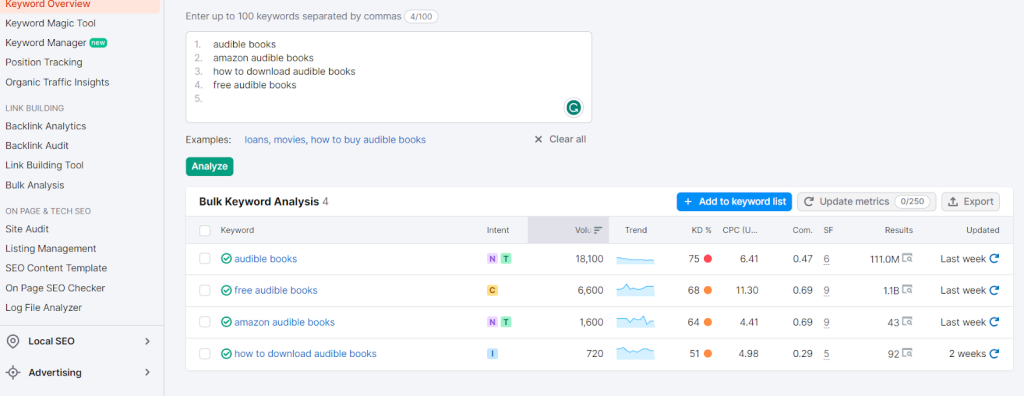
II. Keyword Magic Tool
Semrush didn’t stop with the basic overview. To take it to the next level you have the Keyword magic tool by your side.
Don’t trust us? See the magic for yourself.

For the keyword “audible books” we have 22,161 keywords.
Now you know why we said it has a huge database.
But do you need all these keywords? Well, no. And Semrush gets it. That said you can easily filter out keywords.
Broad Match ( Any variation of the seed keyword)
Phrase Match (exact keyword or keyword phrase in a different order)

Did you see, the list got narrowed down to 13,615 keywords?
Exact match (exact keyword or the keyword phrase in the same order)

The list just gets smaller making your process a lot easier and saving hours.
Related ( Keywords similar to the seed keyword)

You also have the option to get question-type keywords and apply the same filter to them.
That’s not it, you can customize the matrices as well.
Semrush’s keyword magic tool has the same matrices as in the overview.
The only difference is that you have thousands of keywords and their score right-hand side to the right.
The matrices include:
- Intent
- Related%
- Volume
- KD
- CPC
- Competitive density and
- Results
Our favorite?
Well, we love the include and exclude features. It allows users to include phrases or exclude certain phrases from the keyword list.
Keyword Manager

You have analyzed the keywords and made a list of keywords, given the folder a name. What next?
Is that all Semrush can do?
Nope, there’s more to this comprehensive SEO tool.
You can manage the keywords in your folder. Here we will use the Audible folder we created.
III. Keyword Manager
The Keyword manager is a new addition to Semrush’s feature.
With this tool, you will find all the keywords you gathered from Keyword Overview, Keyword Magic Tool, Organic Research, and Keyword Gap.

We haven’t arrived at the best part yet: The keyword clusters and mind map option.
The keyword clusters take into account different factors like the intent, ranking potential, difficulty, etc to group all the keywords into different categories.
It helps you understand the keywords with high-ranking potential.

Coming to the Mind map, it’s nothing but a pictorial representation of the clusters.
As you can see, we have 22 clusters with 281 keywords with the seed keyword being “audible”.

Fun fact: You can look at the total volume of all the keywords in the list as well as the total volume of keywords in each cluster.
2. Link Building
I. Backlink Analytics: One of the biggest things in SEO is doing the backlinks the right way.
Semrush’s backlink analytics tool makes it way easier for businesses to analyze the quality of backlinks.
You just have to enter the domain name to get a list of backlinks to that site.

At the top of the entire page you have everything, the referring domain, backlink, monthly visit, organic traffic, outbound domain overall traffic score, authority score, authority score trend, and network graph.

Seems overwhelming to analyze right?
Well, it can be at the beginning.
You don’t have to understand each metric right there. They have a separate section for each of these metrics.
Now if we click on the network graph next to the overview you can have a section specific to that particular metric.

You can utilize this network’s color-coded network to assess a domain’s relevance and link-building potential. Additionally, it displays the top three tiers of relevant referring domains for the website under analysis.
With the guidance, you may more easily: Discover pertinent domains for your niche
- Determine whether a domain or its backlinks have ambiguous external connections.
- View the backlink profile of a domain’s strengths and weaknesses.
- Examine a domain’s standing and applicability in its specialized field.
This is for you if you’re an outreach specialist, an SEO who performs competition analysis, or a backlink researcher.
You can also do the same for Backlink, Anchor text, Referring Domain, IPs, etc.
We will get to them one by one.

You can also filter the backlinks to New, Old, Lost, Follow, No follow, Sponsored, etc.
That’s not it! Semrush allows you to filter backlinks as per the reference page. You can select if the backlinks are from Wiki or an e-commerce store, blog, etc.
Further, you can choose to see the backlinks that are placed in header content or sitewide.

Want to know your and your competitor’s top-performing anchor text?
The anchor text section gives you the top-performing text along with the number of backlinks and a number of domains.
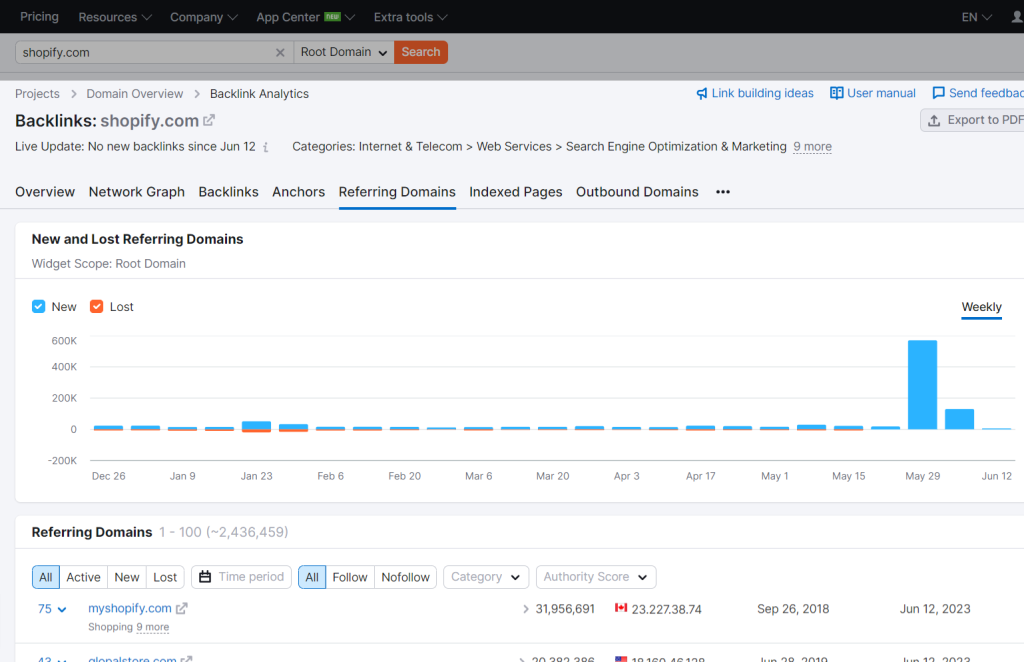
The Referring Domain section gives you the list of external sites that have linked to your website.
It’s beneficial because you can track the websites from where you have lost links, analyze them, and improve.
You can also focus on the sites that are newly linked back to your website.
All these features might seem irrelevant at times and we have seen enterprises ignore them. But when combined together they can make or break your SEO.
II. Backlink audits: You know the type of backlinks you have, and where they come from. However, analyzing which backlink is toxic or not manually can be difficult.

To save you time, a Semrush backlink audit can come in handy. It indicates the toxicity of backlinks.
The color code specifies different toxicity levels. The red is for toxic links, the orange is potentially toxic, and the green is for non-toxic.
The best part is you can send backlink removal requests to the website owner through the audit interface.

Semrush gathers the email of the website owner and has a few link removal email templates. Just a few clicks and your link gets removed.
If the link cannot be removed even after contacting the website owner. You can disavow the links by requesting Google to ignore them.
Do what you will with that information!
III. Link building with Semrush: One of the out-of-the-box tools by Semrush is its link-building tool.
If you are wondering what link building is, it is simply getting backlinks from an external website.
For this, you have to enter the domain for which you want to build backlinks, and enter a few keywords and their competitors.
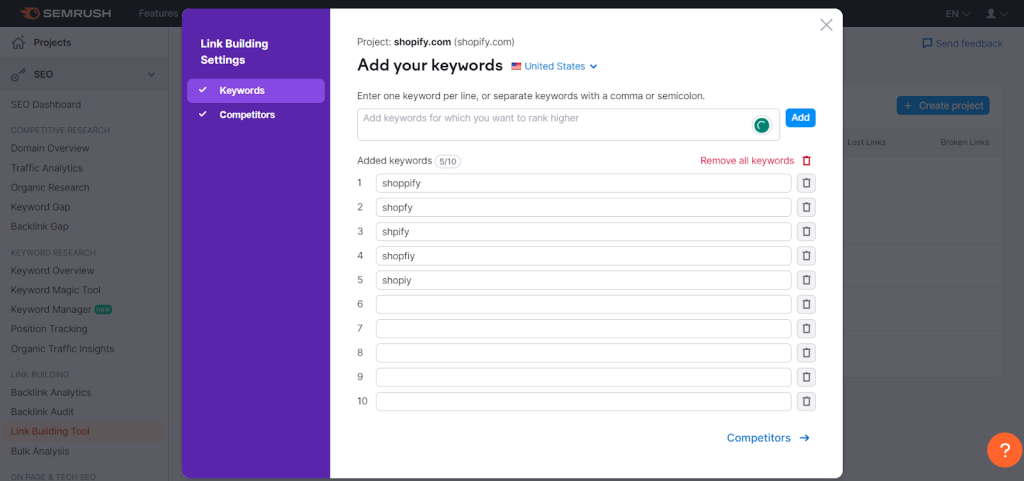
They crawl through a list of websites that your competitors have backlink from, websites that have backlink for the keywords and get back to you with list of prospects.

Let’s see the list of prospects we have:

You can reject prospects from the list, select an outreach strategy, and export the list in CSV format.
Not just that, Semrush specifies the URL type which can be general, news, blogs, forums, etc.
You can also connect to your email, create a mail template and reuse it.
More reasons to start the free trial.
3. Competitor Analysis
The Competitor Analysis tool has five sections: Domain overview, Traffic analyser, Organic Research, Keyword Gap, and Backlink Gap.
We will have a quick look at the Domain overview and Traffic analyser.
The one that we would love to spill the beans on is the Keyword Gap and Backlink gap.
I. Domain overview: The domain overview gives you a thorough idea of how well a domain performs( in this case your competitor)
Semrush allows you to enter a domain, subdomain or a URL. You can use any competitor link you wish to analyse.
Here we have taken amazon.com.

Voila! You have tons of data and metrics to beat your competitor in no time. A few metrics we are absolutely in love with will be the authority score, organic search traffic, paid search traffic, and backlinks.
You can get more precise results by choosing the geographic location. The best part? You can compare domains, analyze growth reports and compare by country.
II. Traffic Analytics: Traffic analytics by Semrush lets you compare your domain with three competitor domains.
You have to enter the link of three competitor domains. Once you do, the magic unfolds.

We have taken Amazon as the main domain. We are comparing its traffic against Walmart, eBay, and Target.
In seconds Semrush figures out the visits, unique visitors, pages per visit, average visit duration and the bounce rate of these four websites.
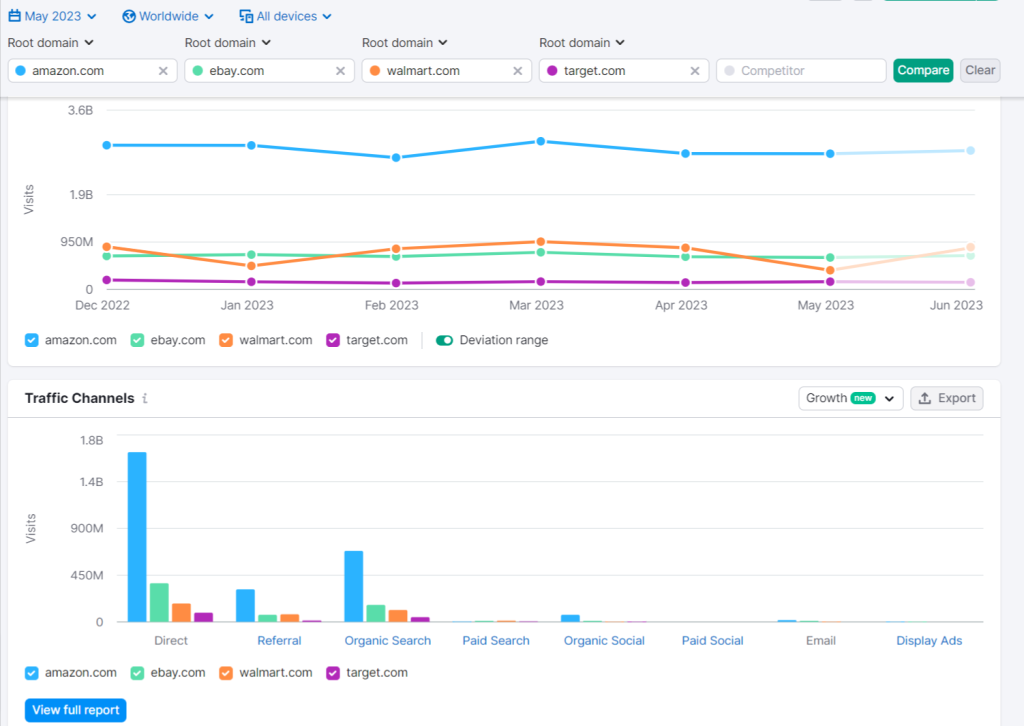
Since it’s Semrush you can bet on filtration options. Narrowing down things for you seems like their thing.
You can choose the country, devices, duration of the report, create a list, export data, and whatnot!
Further, Semrush helps you understand your competitor’s traffic channel.

Last but not the least, the traffic journey.

You can figure out the top traffic source and top destination of each competitor.
By clicking on all sources and destinations, Semrush will lay down every source and destination of the traffic.
III. Keywords Gap: We have used it several times and can vouch for it.
You can compare the organic and paid keywords with five competitors.

Not just the results, but also the way they represent it is wow-worthy. Even with little SEO knowledge, one can understand what’s going on.
The analysis gives you keyword opportunities and their volume.
Further down the page, you can find all keyword details for[Your primary domain]
Here’s it’s Amazon. Yet you can instantly change it to any of the competitors you entered and see witness the changes.
Do try it out!

IV. Backlinks Gap: We have already shed light on how backlinks work. In the backlink gap tool, Semrush asks from the competitor you want to find backlink gaps for.

Once it has the link, it analyses their backlinks and gives you a list of prospects to outreach.
You can delete these prospects or start outreach right from their interface.
You can also find weak, strong, shared, and unique backlinks.
4. Local SEO
In this section, we will have a complete breakdown of the Local SEO tool by Semrush.
This section has four major tools under them.
- Listing Management
- Position Tracking
- On-Page SEO Checker
- Social Media Toolkit
To review the listing management feature we have considered the Thump Coffee Shop( Suggested by Semrush).
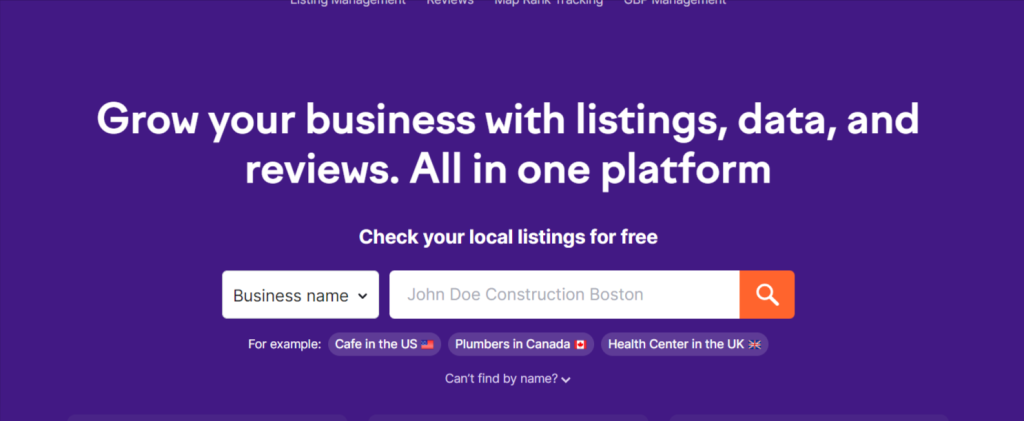
Enter your business name. We took the suggested keyword in the example. “Cafe in the US”
Once you enter the search button you will have a simple clear interface. ( screenshot below)

The tool accesses your online presence to give it a score of Bad, Moderate, or Good.
You can also find the total number of listings and which of them you have to fix.
Since it is kind of an overview, you can also view your ratings.
If you are concerned about ratings and reviews. Not to worry, Semrush has a separate feature to manage them.

The listing management tool does not just give you a score but also suggests ways to fix the errors and improve your reach.
Coming to the next tool, we have review management.
Manual review management is a pretty tedious task.
Understanding your customers, replying to each of their reviews, analyzing reviews, and creating a management strategy is like walking on a bed of thrones.
With Semrush review management you won’t miss to reply to a review. Once you are done with the reviews Semrush gives you a satisfactory 100% score.
You can also discover the most common words used in your review. This is a part of their unique sentiment analysis tool.
Further, you can trace the dependency of your reviews on your business’s visibility.

Wait there’s more to it. You can also spy on your competitor’s review, and understand their management strategy.

Next up is the Position Tracking Tool.

Semrush’s Position Tracking finds out cannibalizing pages your site might have.
Cannibalizing pages refer to multiple pages on your website that are targeting the same keyword.
These pages hurt your organic performance.
Once you share your business information with Semrush, you can effortlessly share this information across maps, applications, search engines, and aggregators.
However, this feature is only available in the United States, the United Kingdom, France, Germany, and Australia.
In case there is a sudden drop in position, Semrush sends you a notification to make you alert.
Have you checked out their Share of Voice line graph that gives you a glance at your website performing on the SERP.
Last but not the list is their Site audit and On-Page SEO checker.

The site audit tool works like any normal site audit tool. They crawl through each and every page of your site to find if anything fishy is going on.
By analyzing a bunch of parameters they provide your site with a health score.
The tool also specifies the status of each page and categorizes them as healthy, broken, have an issue, redirected, or blocked. ( Screenshot above)

You will also have a list of recommendations to guide you through each issue. Semrush assists you in every step of fixing your error.
5. Content Marketing
I. Topic Research: The Topic Research tool helps you get topic ideas for a particular keyword.
You have to enter the keyword in the search panel below.

We have used the “best nike shoes” as our keyword.
After a few seconds, Semrush generates content ideas. The ideas are presented in cards.

You can click on the explore option right beside the card button. This will give you the subtopic, content idea, its facebook engagement, backlinks and total number of shares.

You can also analyse the top headings by backlinks and the top 10 interesting questions for your keyword in the overview section.

What we actually like in topic research is its mind map. ( Look at screenshot below)
From this circle you can click on any phrase.
Once you do so, the headlines for that phrase, as well as questions related to it appear on the right side.

II. SEO Writing Assistance: The Semrush SEO writing assistance assigns you a score based on the readability and originality of your content.
It highlights issues in your content and suggests ways to fix them.
You can easily share the report with your editorial team to fasten the process.
Semrush also allows you to export the report to google docs.
You can integrate Semrush with google docs for better results.

III. Content Analyzer: You will find two sub-tools under this tool. One is content audit and the other one is Post tracking.
The content audit analyses sub-folders in the website and finds pages that need improvement.
You can audit up to 50 pages in the free plan. The number of pages increases with your increase in plan level.
You can choose the subfolders that are to be analyzed. Once done, the tool will categorize it in the Content set. ( below screenshot)
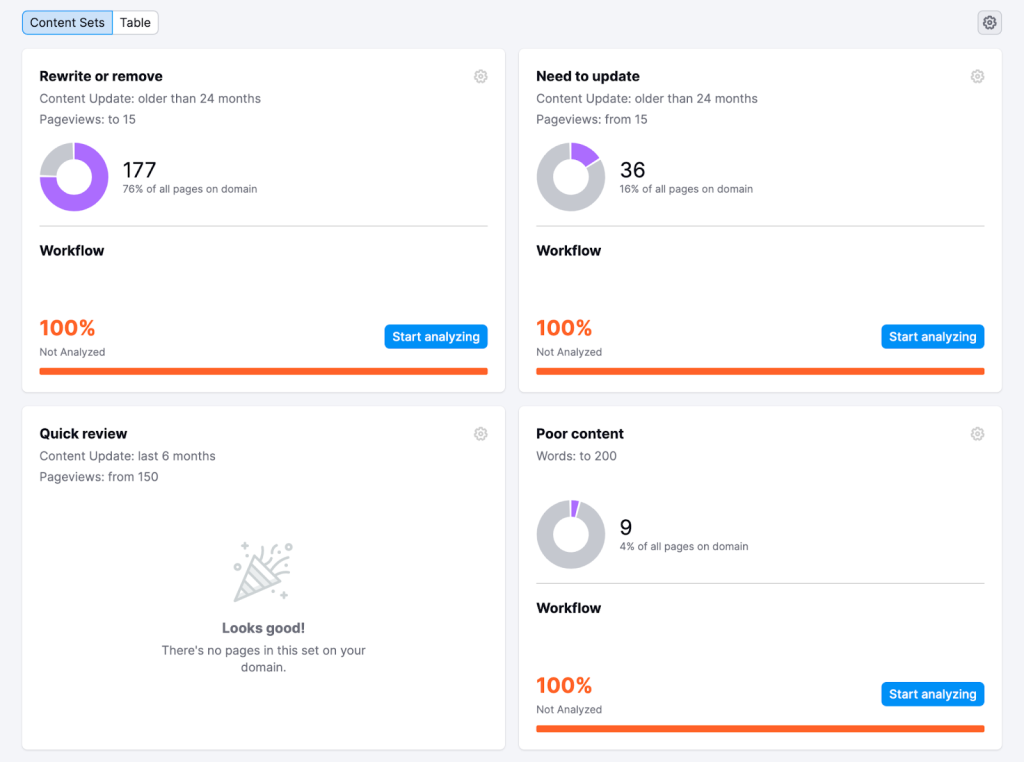
To further analyze each set, you can click on the Start analyzing option.
The second part of the content analyzer is the position tracking.
Enter the content position you want to track. Here’s what you can view:

The interface has 4 metrics: Visibility, Estimated Traffic, Average Position And Share of Voice. ( Watch the video for description of each metric)
Semrush offers a trend chart for each metric.
You can only access the Share of Voice metric with a business subscription. [Link]
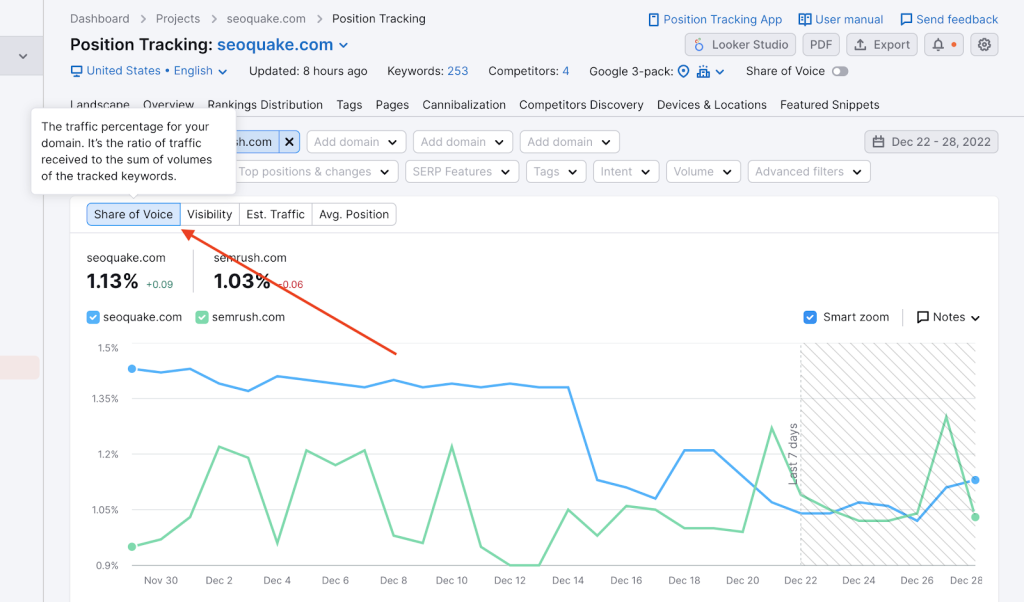
We have found it extremely beneficial as it considers the total combined volume of all of your keywords and tells you the ratio of traffic that each site gets.
6. Social Media
The Social Media Poster does more than simply post on your linked social media account.
Yeah, you have a calendar where you can add and schedule posts on specific dates and times.

The primary and most important tool is the Social Media Poster, which offers much more functionality than its name implies.
They also let you shorten links via bit.ly as well as add custom UTMs for link tracking.
Wait, the fun just began!
Semrush is the boss of uniqueness and when they say they are all in one, they do mean it.
Why?
Even in their poster section, you can edit photos directly at a premium level. The tool has 60 predefined filters and 20 overlays for lighting effects.
Next up is their analytics tool.
We have used several social media analytic platforms, yet the only metric they think is vital is the classic likes, comments, shares, impressions, etc.
Semrush takes it a step further.
Its data are channel specific. In the case of Instagram, you can find out what CTA people are reacting to and the number of profile views due to that particular CTA.
We won’t say the data are 100% accurate, but they give you an approximate idea.
The third in the row is the Social tracker.
You can easily set up the social media channels you consider to be your competitors. Once you do, Semrush does its job to analyze their followers, top posts, change in follower count, etc.
You can check these reports and find out the setbacks of your competitor as well as their strengths. The report perfectly breaks down your performance compared to your competitor through visuals and graphs.
Earlier users had one complaint. They can’t manage comments directly through Semrush.
Hence, they worked on it and got you the social inbox feature.
This is where you can track and manage the comments, mentions, and DMs on social media channels.
You can classify messages for better management.
There’s more! You can assign messages to colleagues for better workflow management.
Of course, whenever you have a reputation crisis, Semrush has you back with actionable solutions.
7. Advertising:
I. Marketing Analysis: This tool has 4 sub tools: Domain overview, advertising research, and PLA research.
The domain overview is exactly the same as that of the Domain overview in the competitor analysis tool under the SEO feature.
Hence, we won’t be discussing that in detail.
Let’s jump to the advertising research tool.
We make the most out of it for competitor analysis.

You can see the paid search trends of your competitors.
The interface gives you a view of the paid search trends from estimated traffic to keywords or traffic costs.
The tool provides the most profitable ad and examples of your competitor’s live ads.
The next tool that has caught our attention is the PLA research tool.
PLA are the Google shopping ads that appear once the user makes a search query.
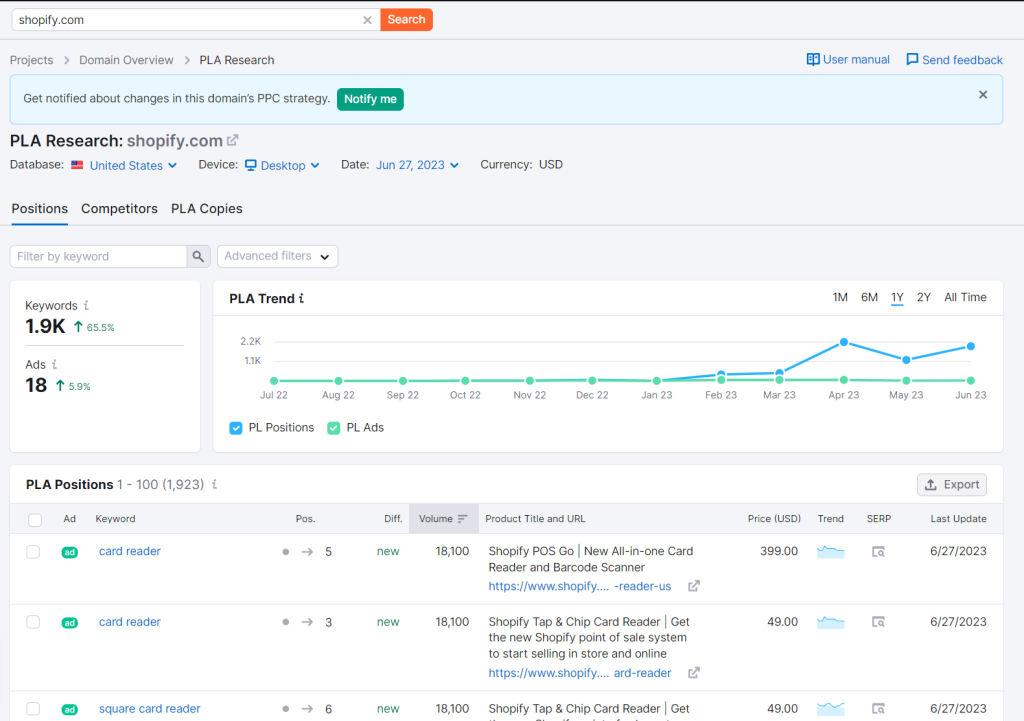
The tool helps you analyze your competitor’s position in shopping ads, discover listing ads that showed up for keywords you are targeting, and much more.
A detailed keyword analysis is one of our favorites. If you are an e-commerce site looking to skyrocket your advertisement do check out their PLA research tool.
II. Keyword Research: In order to do your keyword research Semrush will ask you to fill in a few details.
Once you click on the research button, you will see a message as below.
We have selected From Semrush to move forward.

Next, you have to enter the location, enter the domain, location, region and city you are targeting.
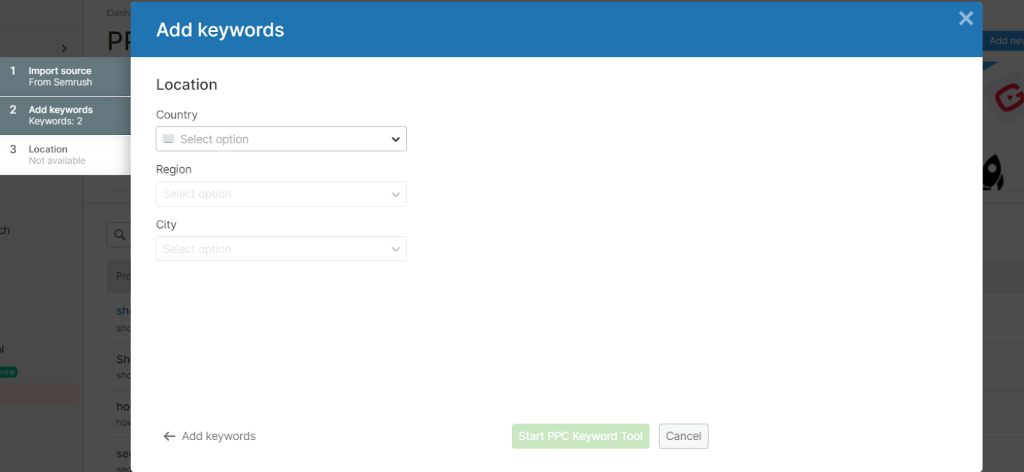
Once you have filled out this information you will have a list of keywords that you can use for your campaign.

Look at the bunch of keywords you got. We will say these keywords need a lot of filtration but it’s a great place to start your campaign keyword research.
You can easily remove duplicate keywords, and view cross-group negative keywords.
The interface also allows you to take several actions including Clean keywords, Add match type, Move to negatives, Move to group, Delete selected, and Auto grouping.
You can also view negative keywords, which if you know are extremely important for PPC Ads.
III. Keyword Ad history: Through the keyword ad history, you can find all the domains that previously used the keyword and what they bid for it. ( Screenshot below)
The tool specifies the number of times the keywords were used in paid searches.
This will help you identify advertising trends.

The keyword Ad tracking under the advertising toolkit is almost similar to the position tracking feature we review earlier in this article.
You can navigate to the keyword research section under the SE toolkit to find out more.
8 .Trends
I. Traffic Analysis: This traffic analytics tool is similar to that of Traffic analytics in the competitor analysis section.
You can either check with one competitor or have a bulk analysis of up to 100 competitors.

The traffic analytics covers every aspect including the number of visitor, number of unique visitors, bounce rate, etc.
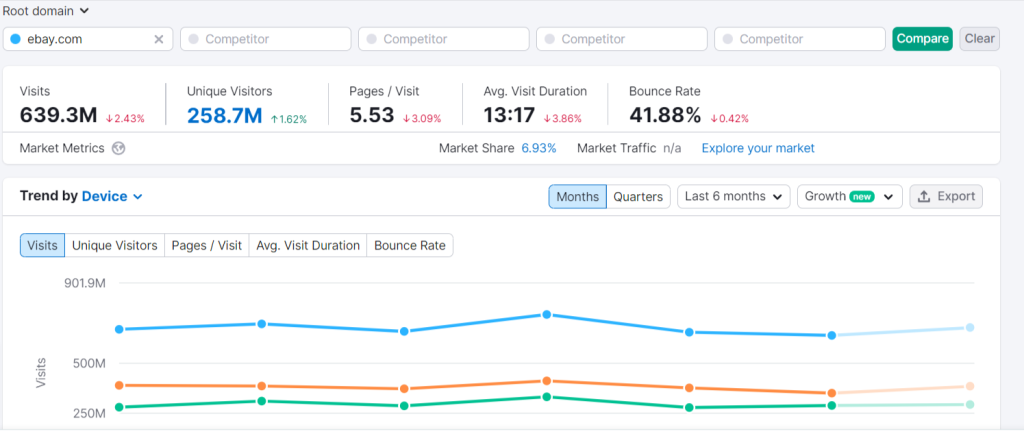
You can also get their top pages, traffic channels by types, traffic journey as well as distribution by country.

Another section in this tool that caught our attention is audience distribution.

They have some expected metrics like demographic, gender, country, etc.
But with the socioeconomics and the behavior section, Semrush has won our hearts.
II. Market Explorer: We haven’t come across any other tool with such details.
The market Explorer is further divided into an overview, audience, benchmarking, and All domains.
Let’s walk through them one by one.
These might be overwhelming, but Semrush has a How to use it guide for each and every section.
In the first section of the overview, you can have an idea of the market domains which specifies the overall domains in that market.
In this case, we are studying eBay. So the market we are looking at in the screenshot is e-commerce.
You can also look into the total market traffic and traffic cost.
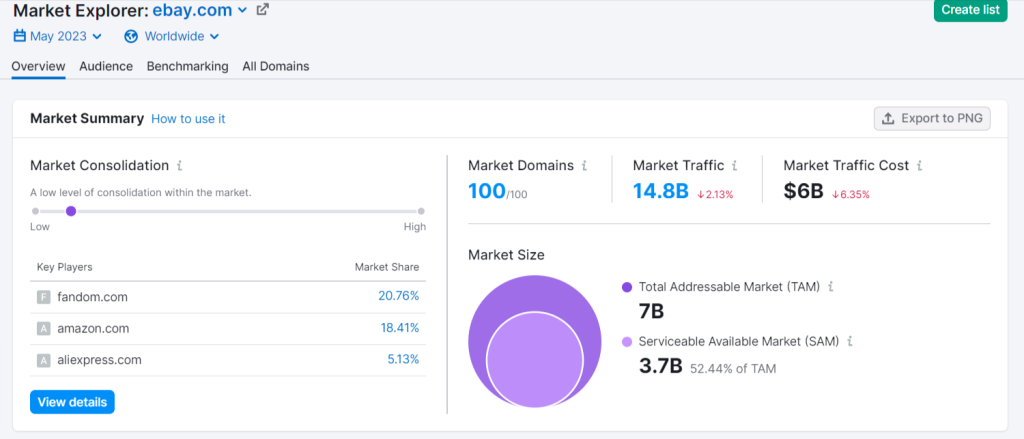
Further down the page, you have the growth Quadrant.
You can select the X-axis parameter and Y-axis parameter to view different growth quadrants.
Here we have taken total traffic against total traffic growth %.
You can point your cursor on each line to see the highlights.

The overview also gives you the top-performing keywords as well as the analysis of each keyword. ( above SS)
If you think you have enough data. Semrush will catch you by surprise.
Cause you have the detailed domain vs market analysis down the page waiting for you.
You can click on any domain and it will showcase the Total traffic trend, its growth by source, traffic generation strategy and its audience.

Moving to the next section, we have the detailed audience analysis.
We already discussed audience overview in traffic analytics but the market explorer takes it even further.
You have all the parameters in traffic analytics presented in detail with additional parameters like audience interest, social media usage, and visited domains.
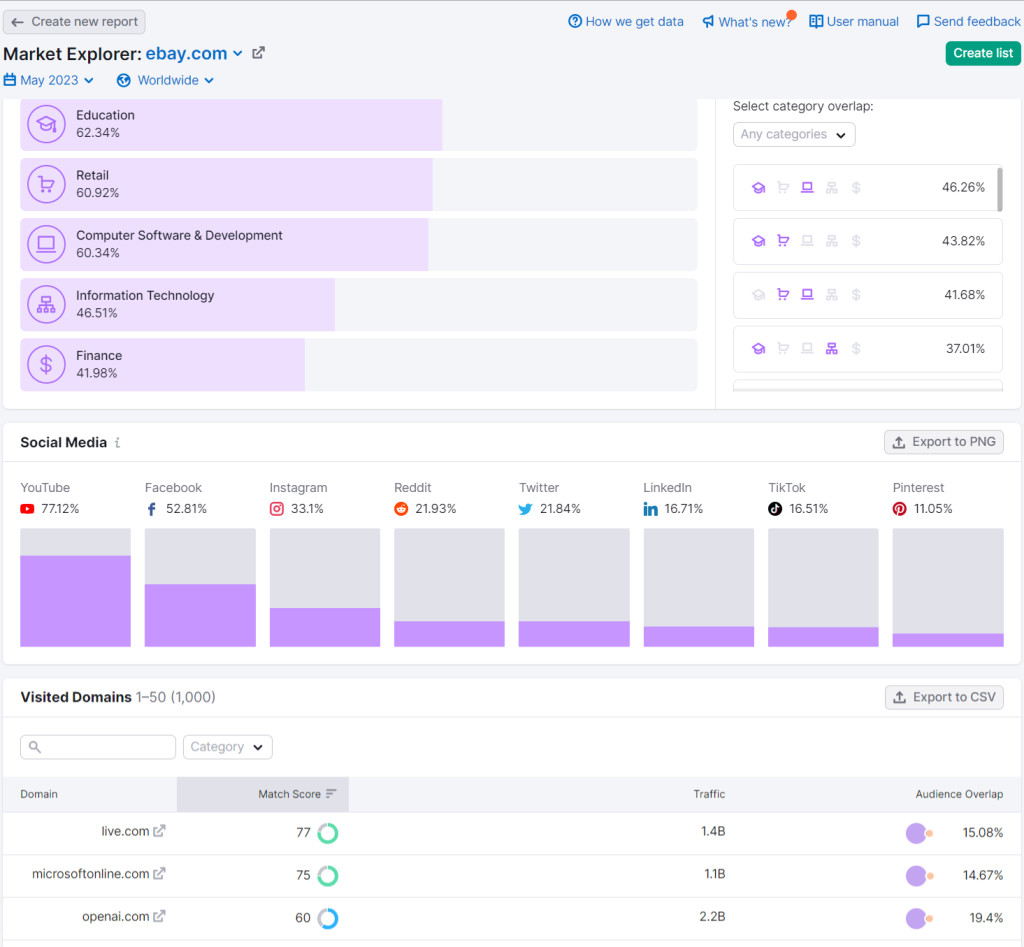
In the last section, you can see all the domains analyzed, their total traffic, direct traffic, referrals, organic search, and paid search.

Does the benchmarking feature interest you?
This is how it looks like

The features of EyeOn and One2Target extensions are discussed here.
One2target solely focuses on your audience whereas EyeOn is gives you a closer on your competitor’s domain.
Find these features tempting? Start exploring the Semrush Market Explorer right away!
Semrush Pricing
You know how the tool works and what wonders it can do, but is it worth paying a minimum of $100 per month?
We would say, that depends on your requirement. If you are looking for a comprehensive tool and do not have time to juggle between one tool to the other, Semrush is your best shot.
In fact, some of its features are unbeatable. Use it properly and your ROI will have no bounds.
Here’s the pricing plan:
- Pro – $119.95 per month.
- Guru – $229.95 per month.
- Business – $449.95 per month.
- Enterprise – Customised pricing
If you plan for a long-term commitment to SEO, you can have the yearly package and save 16% on the total billing amount.
They might charge you extra for the following activities:
- Adding extra users: $45 per user
- Purchasing Competitive intelligence feature: $200 per month
- Local listing management( Basic): $20 per month
- Local listing management( Premium) :$40 per month
Even though Semrush is a bit expensive compared to its competitors, it’s worth every penny. You ask why?
- It has the largest database, making the results more accurate
- It’s a comprehensive tool, you get everything under one roof
- It offers the largest number of features.
- And let’s not forget their ease of use and customer service.
Still, figuring out whether it is suitable for your business?
We suggest the best way is by signing up for their free trial.
Semrush Interface and ease-of-use

The Semrush interface is clear and easy to navigate. You can switch from one functionality to another in no time.
The menu of functionalities are placed on the left hand side. You can access each tool separately in the right hand side.
You have 5 toolkit on the left:
- SEO
- Local SEO
- Content marketing
- Social Media
- Advertising
- Trends
The data visualisation helps you overcome the feeling of information overload because the majority of the metrics are graphed in a way that makes the information more clearer.
Nevertheless, it would be wonderful if Semrush’s user interface could be improved to function better with smartphones.
As it is, Semrush’s user interface is not “responsive,” so when you log in on a mobile device, you get the usual desktop screen.
You have to pinch and zoom a lot and work with very little text as a result.
Semrush Integrations
You can integrate Semrush with Google Analytics, Google search console, Google accounts,, and other Google products.
You also integrate Semrush on social media channels and their partners.
Check out the complete integration guide here.

Semrush Customer Support
There are three ways by which you can contact the Semrush Team.
You can send them a mail or opt for their live chat option.
If your issue is not resolved through these methods you can fill the contact form. The Semrush team will get in touch with you.
However, the contact option is only for weekdays and during business hours only.
If you are stuck with something on weekends, don’t expect Semrush to resolve it.
Semrush Comparison
We won’t be wasting your time with a detailed review here.
To make it short and to the point we have represented the differences in tabular form.
You can easily compare these competitors and choose the one that’s suitable for your business.
Semrush Vs Ahrefs
| Parameter | Ahrefs | Semrush |
| Link Features | Comprehensive link analysis capabilities | Extensive backlink analysis with advanced reporting |
| Keyword Features | Robust keyword research and analysis tools | Detailed keyword research, tracking, and optimization features |
| Value | Considered valuable in terms of SEO features and data | Wide range of SEO and digital marketing tools in one platform |
| Support and Documentation | Reliable support and helpful documentation | Responsive customer support and extensive knowledge base |
| New Feature Updates | Regular updates and addition of new features | Continual introduction of innovative features and improvements |
| Bugs and Problems | Generally stable, with occasional bugs and issues | Proactive bug fixing and prompt resolution of reported issues |
| Overall Value | Considered as a preferred tool for SEO | Highly regarded as an all-in-one SEO solution for businessesUsability |
Semrush Vs SpyFu
| Parameter | Semrush | SpyFu |
| Usability | User-friendly interface and intuitive navigation | Beats Semrush by a small margin in terms of usability |
| Competitor Keyword Research | Offers competitor keyword research capabilities | Specializes in competitor keyword research with a smaller feature set |
| Database and Features | Bigger database and packed with more features | Smaller feature set but focuses on competitor analysis |
| Domain Analysis | Complete set of tracking tools for domain analysis | Can turn competitor data into readable metrics like estimated monthly ad budget and SEO click value |
| Competitive Research | Strong competitive research capabilities | Equally capable in terms of competitive research |
| Price-to-Performance Ratio | value for money | Costs around a third of the price of Semrush’s entry-level plan |
| Suitable for | Best used by teams with different priorities | Suitable for new bloggers with lightweight and essential SEO tools |
Semruush Vs Moz
| Parameter | Moz | Semrush |
| Keyword Research | Keyword Explorer provides target keywords, monthly search volume, competition ranking, and priority score. | Keyword Overview and Keyword Magic Tool offer detailed keyword analysis, difficulty, trends, related keywords, and SERP analysis. |
| Link Building | Link Explorer helps evaluate existing link profiles, track link-building efforts, and find prospects. | features a bigger link index, backlink research, outreach, and multiple filters for effective backlink discovery. |
| Technical SEO | Provides step-by-step instructions for improving website content and page optimization. | Offers in-depth site audit, detects technical issues, and provides insights on site errors and internal link distribution. |
| PPC and Advertising Research | Offers PPC optimization, keyword suggestions, and search volume estimations. | Evaluates competitors’ marketing approaches, ad spending, and provides market exploration data. |
| Customer Support | Offers email support, community, and a forum for queries. | Offers live chat, phone, email support, and community, ensuring multiple channels for assistance. |
| Pricing | Offers different plans starting from $99/month for beginners up to $599/month for big businesses. | Offers various plans ranging from $119.95/month for beginners up to custom plans for specific requirements. |
| Ease of Use | Basic user interface, exporting data can be time-consuming. | Highly user-friendly, well-organized sections, visually appealing graphs, and easy data analysis. |
Semrush Alternatives
Semrush is a comprehensive tool. Hence if you need a tool only for a specific requirement, here are some alternatives.
Keyword Research
Ahrefs: A popular SEO tool that offers comprehensive keyword research features, including search volume, keyword difficulty, related keywords, and SERP analysis.
Google Keyword Planner: A free tool by Google Ads that provides keyword ideas, search volume, and competition data for effective keyword research.
KWFinder: A user-friendly keyword research tool that offers keyword suggestions, search volume, difficulty score, and competitive analysis.
Competitor Analysis
SimilarWeb: Provides insights into competitor website traffic, audience demographics, referral sources, and popular content to help you analyze and benchmark against your competitors.
SpyFu: Offers competitor analysis tools to uncover your competitors’ organic and paid search strategies, keyword rankings, ad copy, and backlinks.
Semrush: Apart from being a comprehensive SEO tool, Semrush also provides robust competitor analysis features, including traffic analysis, organic and paid keywords, backlinks, and more.
On-Page SEO
Yoast SEO: A popular WordPress plugin that helps optimize on-page content by providing suggestions for keyword usage, meta tags, readability, and overall SEO improvements.
Screaming Frog: A website crawling tool that helps identify on-page SEO issues such as broken links, duplicate content, missing meta tags, and more.
Moz Pro: Offers on-page optimization features, including page audits, recommendations for improving content and HTML elements, and tracking keyword rankings.
Backlink Analysis
Ahrefs: Renowned for its extensive backlink database, Ahrefs provides detailed backlink analysis, including referring domains, anchor text, link quality, and competitor backlink analysis.
Majestic: Offers a comprehensive backlink analysis tool with features like Trust Flow, Citation Flow, backlink history, anchor text analysis, and link profile comparison.
SEO SpyGlass: Part of the SEO PowerSuite toolkit, SEO SpyGlass helps analyze backlinks, identify toxic links, monitor competitor backlinks, and track backlink progress.
Social Media
Hootsuite: A popular social media management platform that allows you to schedule and publish posts, monitor social media mentions, and analyze engagement across multiple social networks.
Buffer: Offers social media scheduling, analytics, and engagement tools, allowing you to manage and optimize your social media presence.
Sprout Social: Provides features for social media scheduling, content publishing, audience engagement, and social media analytics to help you grow your social media presence.
Advertising
Google Ads: Google’s advertising platform that allows you to create and manage PPC campaigns, target specific keywords and demographics, and track ad performance.
Facebook Ads Manager: A powerful advertising platform that enables you to create and manage ads on Facebook and Instagram, target specific audiences, and track campaign performance.
Microsoft Advertising: Similar to Google Ads, Microsoft Advertising (formerly Bing Ads) allows you to create and manage PPC campaigns on the Bing search engine, reaching a different audience.
Conclusion
Semrush is a versatile and valuable tool for digital marketers seeking to elevate their online presence.
With its extensive features and insights, it offers a comprehensive solution for keyword research, competitive analysis, and optimizing digital campaigns.
While there may be a learning curve for newcomers, the platform’s robustness and depth make it worthwhile.
Whether you are an experienced marketer or a novice looking to enhance your online visibility, this Semrush’s review and video walkthrough has valuable insights to assist you in making informed decisions and maximizing your digital marketing efforts.
How Long is Semrush’s Free Trial?
In order to try and test the tool for yourself and analyze whether it suits your needs the tool offers 7 days free trial.
Can I cancel Semrush free trial?

Cancelling the free subscription is no rocket science.
Semrush allows you to cancel the free subscription through it;s subscription page or you can directly click on this link.
Go to the subscription page. There you will find a link with text ” Active”. Click on teh contact us link to the cancellation form.
If you cancel through the link, you have to log into your account.
Semrush will hand over a form. Fill it and click on the submit button.
For any further assistance or trouble during cancellation you can contact their customer support for assistance.
Is Semrush worth it?
Assuming that you have read the review, you know Semrush is an All-In-One Marketing tool catering to multiple requirements under one roof.
It might be more expensive than other tools, but considering its level of accuracy, user interface, and customer support we feel it is worth paying for.
But, don’t just take our word for it. You always have the free trial option to check it out yourself and then decide what’s best for your business.
How accurate is Semrush?
Semrush is one of the most trusted tools for online marketing in the industry. To ensure that its data is helpful rather than hurtful it incorporated a neural network.
It is a set of algorithms that scraps through data, analyses it and understands the pattern.
Although we would like to point out that no tool is 100% accurate, Semrush outperforms almost all other tools for most of its features.
Why is Semrush expensive?
Knowledge is money….more refined data is money. And the quality of data alongside the features Semrush provides comes with a price tag.
There are several options in the market that offer online marketing tools yet very few offer the level of sophistication that Semrush has built for its users.
What is SemrushBot?
SemrushBot is the search bot software that Semrush sends out to discover and collect new and updated web data.
SemrushBot is like a crawler designed by Semrush
Semrush Bot is a web crawler developed by Semrush. Web crawlers, also known as spiders or bots, are algorithms that navigate through web pages to gather data.
Semrush Bot visits websites and analyzes their content, keywords, backlinks, and other SEO-related factors.
These data are presented to you in the form of numbers and metrics to optimize their online presence and improve their search engine rankings.
How Does Semrush Collect Data?
Semrush has built its own algorithm over the years. Just like Google crawls through web pages, Semrush’s algorithm crawls through web pages and gathers data for its database.
They use different techniques to collect the most up-to-date data and different types of information. They further filter the data and present it to the market.
What is Authority Score in Semrush?
The Authority Score by Semrush is a metric that indicates the overall quality, trustworthiness, and authority of a web page.
Anything higher than 60 is considered to be a good authority score. Above 80 is a dream come true for many businesses.
The authority score depends on several factors like domain backlink, strength of content, etc.
What is the Traffic Cost in Semrush?
Now this one has serious confusion going around.
Traffic Cost on Semrush gives you the cost estimation of bidding for an organic keyword through Google ads.
This gives you an idea of the amount you will save through content marketing and organic reach compared to investing in Google Ads.
Let’s say the traffic Cost shows to be $3k.
This indicates that you will need $3k to drive the same quality and quantity of traffic through Google Ads.